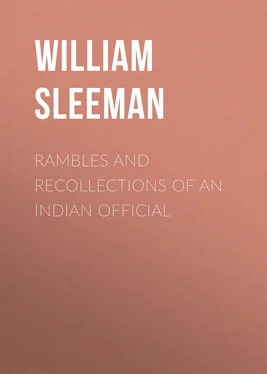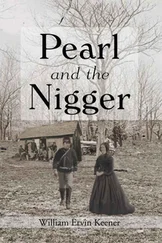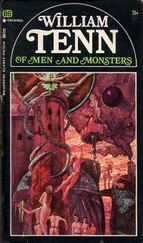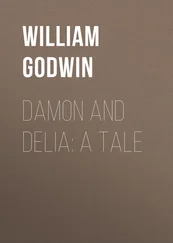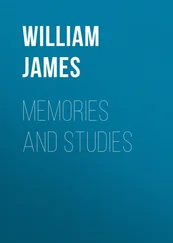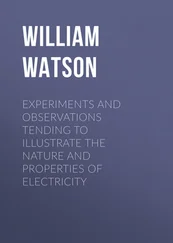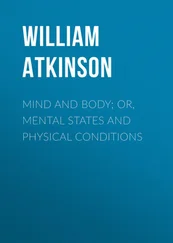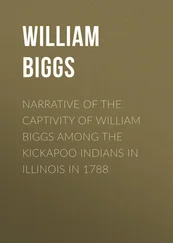William Sleeman - Rambles and Recollections of an Indian Official
Здесь есть возможность читать онлайн «William Sleeman - Rambles and Recollections of an Indian Official» — ознакомительный отрывок электронной книги совершенно бесплатно, а после прочтения отрывка купить полную версию. В некоторых случаях можно слушать аудио, скачать через торрент в формате fb2 и присутствует краткое содержание. Жанр: Путешествия и география, История, foreign_edu, foreign_antique, foreign_prose, на английском языке. Описание произведения, (предисловие) а так же отзывы посетителей доступны на портале библиотеки ЛибКат.
- Название:Rambles and Recollections of an Indian Official
- Автор:
- Жанр:
- Год:неизвестен
- ISBN:нет данных
- Рейтинг книги:4 / 5. Голосов: 1
-
Избранное:Добавить в избранное
- Отзывы:
-
Ваша оценка:
- 80
- 1
- 2
- 3
- 4
- 5
Rambles and Recollections of an Indian Official: краткое содержание, описание и аннотация
Предлагаем к чтению аннотацию, описание, краткое содержание или предисловие (зависит от того, что написал сам автор книги «Rambles and Recollections of an Indian Official»). Если вы не нашли необходимую информацию о книге — напишите в комментариях, мы постараемся отыскать её.
Rambles and Recollections of an Indian Official — читать онлайн ознакомительный отрывок
Ниже представлен текст книги, разбитый по страницам. Система сохранения места последней прочитанной страницы, позволяет с удобством читать онлайн бесплатно книгу «Rambles and Recollections of an Indian Official», без необходимости каждый раз заново искать на чём Вы остановились. Поставьте закладку, и сможете в любой момент перейти на страницу, на которой закончили чтение.
Интервал:
Закладка:
All the people who come to bathe at the fair bring chaplets of yellow jasmine, and hang them as offerings round the necks of the god and his consort; and at the same time they make some small offerings of rice to each of the many images that stand within the same apartment, and also to those which, under a stone roof supported upon stone pillars, line the inside of the wall that surrounds the circular area, in the centre of which the temple stands. The images inside the temple are those of the three great gods, Brahma, Vishnu, and Siva, with their primaeval consorts; 22 22 Sarasvatī, consort of Brahma; Dēvī (Pārvatī, Durgā, &c.), consort of Siva; and Lakshmī, consort of Vishnu. All Hindoo deities have many names.
but those that occupy the piazza outside are the representations of the consorts of the different incarnations of these three gods, and these consorts are themselves the incarnations of the primaeval wives, who followed their husbands in all their earthly ramblings. They have all the female form, and are about the size of ordinary women, and extremely well cut out of fine white and green sandstone; but their heads are those of the animals in which their respective husbands became incarnate, such as the lion, the elephant, &c., or those of the ' vāhans ', or animals on which they rode, such as the bull, the swan, the eagle, &c. But these, I presume, are mere capricios of the founder of the temple. The figures are sixty- four in number, all mounted upon their respective ' vāhans ', but have been sadly mutilated by the pious Muhammadans. 23 23 The author's explanation is partly erroneous. The temple, which is a very remarkable one, is dedicated to the sixty-four Joginīs. Only five temples in India are known to be dedicated to these demons. For details see Cunningham, A.S.R., vol. ix, pp. 61-74, pl. xii-xvi; vol. ii, p. 416; and vol. xxi, p. 57. The word vāhana means 'vehicle'. Each deity has his peculiar vehicle.
The old 'Mahant', or high priest, told us that Mahādēo and his wife were in reality our Adam and Eve; 'they came here together', said he, 'on a visit to the mountain Kailās, 24 24 The heaven of Siva, as distinguished from Vaikuntha, the heaven of Vishnu. It is supposed to be somewhere in the Himālaya mountains. The wonderful excavated rock temple at Ellora is believed to be a model of Kailās.
and being earnestly solicited to leave some memorial of their visit, got themselves turned into stone'. The popular belief is that some very holy man, who had been occupied on the top of this little conical hill, where the temple now stands, in austere devotions for some few thousand years, was at last honoured with a visit from Siva and his consort, who asked him what they could do for him. He begged them to wait till he should bring some flowers from the woods to make them a suitable offering. They promised to do so, and he ran down, plunged into the Nerbudda and drowned himself, in order that these august persons might for ever remain and do honour to his residence and his name. They, however, left only their 'mortal coil', but will one day return and resume it. I know not whether I am singular in the notion or not, but I think Mahādēo and his consort are really our Adam and Eve, and that the people have converted them into the god and goddess of destruction, from some vague idea of their original sin, which involved all their race in destruction. The snakes, which form the only dress of Mahādēo, would seem to confirm this notion. 25 25 This 'notion' of the author's is not likely to find acceptance at the present day.
CHAPTER 2
The Hindoo system is this. A great divine spirit or essence, 'Brahma', pervades the whole universe; and the soul of every human being is a drop from this great ocean, to which, when it becomes perfectly purified, it is reunited. The reunion is the eternal beatitude to which all look forward with hope; and the soul of the Brahman is nearest to it. If he has been a good man, his soul becomes absorbed in the 'Brahma'; and, if a bad man, it goes to 'Narak', hell; and after the expiration of its period there of limited imprisonment , it returns to earth, and occupies the body of some other animal. It again advances by degrees to the body of the Brahman; and thence, when fitted for it, into the great 'Brahma'. 26 26 Men are occasionally exempted from the necessity of becoming a Brahman first. Men of low caste, if they die at particular places, where it is the interest of the Brahmans to invite rich men to die, are promised absorption into the great 'Brahma' at once. Immense numbers of wealthy men go every year from the most distant parts of India to die at Benares, where they spend large sums of money among the Brahmans. It is by their means that this, the second city in India, is supported. [W. H. S.] Bombay is now the second city in India, so far as population is concerned.
From this great eternal essence emanate Brahma, the Creator, whose consort is Sarasvatī; 27 27 Brahma, with the short vowel, is the eternal Essence or Spirit; Brahmā, with the long vowel, is 'the primaeval male god, the first personal product of the purely spiritual Brahma, when overspread by Maya, or illusory creative force', according to the Vedanta system (Monier Williams, Religious Thought and Life in India , p. 44).
Vishnu, the Preserver, whose consort is Lakshmī; and Siva, alias Māhadēo, the Destroyer, whose consort is Pārvatī. According to popular belief Jamrāj (Yamarāja) is the judicial deity who has been appointed by the greater powers to pass the final judgement on the tenor of men's lives, according to proceedings drawn up by his secretary Chitragupta. If men's actions have been good, their souls are, as the next stage, advanced a step towards the great essence, Brahma; and, if bad, they are thrown back, and obliged to occupy the bodies of brutes or of people of inferior caste, as the balance against them may be great or small. There is an intermediate stage, a 'Narak', or hell, for bad men, and a 'Baikunth', or paradise, for the good, in which they find their felicity in serving that god of the three to which they have specially devoted themselves while on earth. But from this stage, after the period of their sentence is expired, men go back to their pilgrimage on earth again.
There are numerous Dēos (Devas), or good spirits, of whom Indra is the chief; 28 28 Indra was originally, in the Vedas, the Rain-god. The statement in the text refers to modern Hinduism.
and Daityas, or bad spirits; and there have also been a great number of incarnations from the three great gods, and their consorts, who have made their appearance upon the earth when required for particular purposes. All these incarnations are called 'Avatārs', or descents. Vishnu has been eleven times on the globe in different shapes, and Siva seven times. 29 29 The incarnations of Vishnu are ordinarily reckoned as ten, namely, (1) Fish, (2) Tortoise, (3) Boar, (4) Man-lion, (5) Dwarf, (6) Rāma with the axe, (7) Rāma Chandra, (8) Krishna, (9) Buddha, (10) Kalkī, or Kalkin, who is yet to come. I do not know any authority for eleven incarnations of Vishnu. The number is stated in some Purānas as twenty-two, twenty-four, or even twenty-eight. Seven incarnations of Siva are not generally recognized (see Monier Williams, Religious Thought and Life in India , pp. 78-86, and 107-16). For the theory and mystical meaning of avatārs , see Grierson, J.R.A.S. , 1909, pp. 621- 44. The word avatār means 'descent', scil . of the Deity to earth, and covers more than the term 'incarnation'.
The avatārs of Vishnu are celebrated in many popular poems, such as the Rāmāyana, or history of the Rape of Sitā, the wife of Rāma, the seventh incarnation; 30 30 Sitā was an incarnation of Lakshmī. She became incarnate again, many centuries afterwards, as the wife of Krishna, another incarnation of Vishnu [W. H. S.]. Reckoning by centuries is, of course, inapplicable to pure myth. The author believed in Bentley's baseless chronology.
the Mahābhārata, and the Bhāgavata [Purāna], which describe the wars and amours of this god in his last human shape. 31 31 For the Mahābhārata, see ante , note 11, Chapter 1. The Bhāgavata Purāna is the most popular of the Purānas, The Hindi version of the tenth book ( skandha ) is known as the 'Prem Sāgar'. The date of the composition of the Purānas is uncertain.
All these books are believed to have been written either by the hand or by the inspiration of the god himself thousands of years before the events they describe actually took place. 'It was', they say, 'as easy for the deity to write or dictate a battle, an amour, or any other important event ten thousand years before as the day after it took place'; and I believe nine-tenths, perhaps ninety-nine in a hundred, of the Hindoo population believe implicitly that these accounts were also written. It is now pretty clear that all these works are of comparatively recent date, that the great poem of the Mahābhārata could not have been written before the year 786 of the Christian era, and was probably written so late as A.D. 1157; that Krishna, if born at all , must have been born on the 7th of August, A.D. 600, but was most likely a mere creation of the imagination to serve the purpose of the Brahmans of Ujain, in whom the fiction originated; that the other incarnations were invented about the same time, and for the same object, though the other persons described as incarnations were real princes, Parasu Rāma, before Christ 1176, and Rāma, born before Christ 961. In the Mahābhārata Krishna is described as fighting in the same army with Yudhishthira and his four brothers. Yudhishthira was a real person, who ascended the throne at Delhi 575 B.C., or 1175 years before the birth of Krishna. 32 32 The dates given in this passage are purely imaginary. Parts of the Mahābhārata are very ancient. Yudhishthira is no more an historical personage than Achilles or Romulus. It is improbable that a 'throne of Delhi' existed in 575 B.C., and hardly anything is known about the state of India at that date.
Bentley supposes that the incarnations, particularly that of Krishna, were invented by the Brahmans of Ujain with a view to check the progress of Christianity in that part of the world (see his historical view of the Hindoo astronomy). That we find in no history any account of the alarming progress of Christianity about the time these fables were written is no proof that Bentley was wrong. 33 33 It is hardly necessary to observe that this grotesque theory is utterly at variance with the facts, as now known.
Интервал:
Закладка:
Похожие книги на «Rambles and Recollections of an Indian Official»
Представляем Вашему вниманию похожие книги на «Rambles and Recollections of an Indian Official» списком для выбора. Мы отобрали схожую по названию и смыслу литературу в надежде предоставить читателям больше вариантов отыскать новые, интересные, ещё непрочитанные произведения.
Обсуждение, отзывы о книге «Rambles and Recollections of an Indian Official» и просто собственные мнения читателей. Оставьте ваши комментарии, напишите, что Вы думаете о произведении, его смысле или главных героях. Укажите что конкретно понравилось, а что нет, и почему Вы так считаете.
